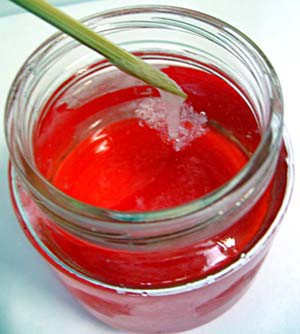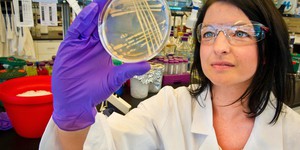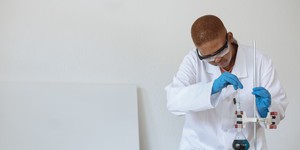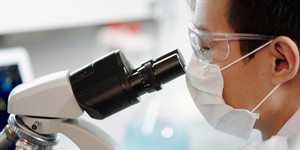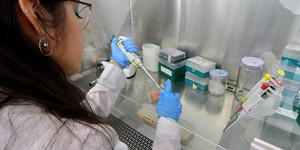Summary
Introduction
Have you ever wondered how scientists get a sample of DNA from a plant, animal, or other organism? All living organisms have DNA. DNA, which is short for deoxyribonucleic acid, is the blueprint for almost everything that happens inside the cells of an organism — overall, it tells the organism how to develop and function. DNA is so important that it can be found in nearly every cell of a living organism. In this activity, you will make your own DNA extraction kit from household chemicals and use it to extract DNA from strawberries.Materials
- Rubbing alcohol
- Salt
- Water
- Strawberries (3)
- Dishwashing liquid for hand-washing dishes
- Measuring cup for liquids
- Measuring spoons
- Glass or small bowl
- Funnel
- Tall drinking glass
- Cheesecloth
- Re-sealable plastic sandwich bag
- Small glass jar, e.g., spice jar or baby food jar
- Bamboo skewer, available at most grocery stores. If you are using a baby food jar or a short spice jar as your small glass jar, you could use a toothpick instead of a skewer.
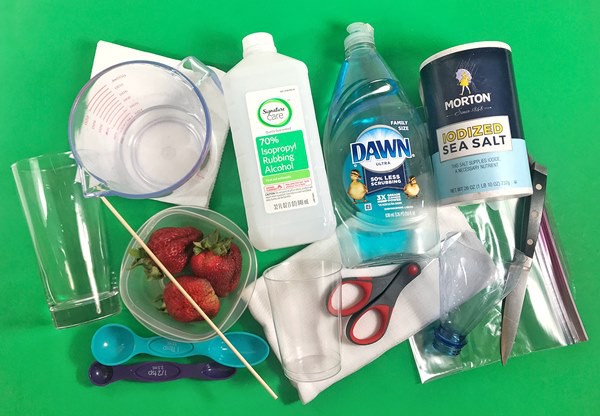 Image Credit: Teisha Rowland, Science Buddies / Science Buddies
Image Credit: Teisha Rowland, Science Buddies / Science Buddies
Prep Work
- Chill the rubbing alcohol in the freezer. You will need it to be very cold to do the activity.
Instructions
- Mix 1/3 cup (C) water, ½ teaspoon salt, and 1 tablespoon (tbsp.) dishwashing liquid in a glass or small bowl. Set the mixture aside for now. This is your extraction liquid, which is what you will use to extract (or remove) the DNA from the strawberries.
- Completely line the funnel with cheesecloth. Put the funnel's tube into a tall drinking glass (not the glass with the extraction liquid in it). Set this setup aside for now.
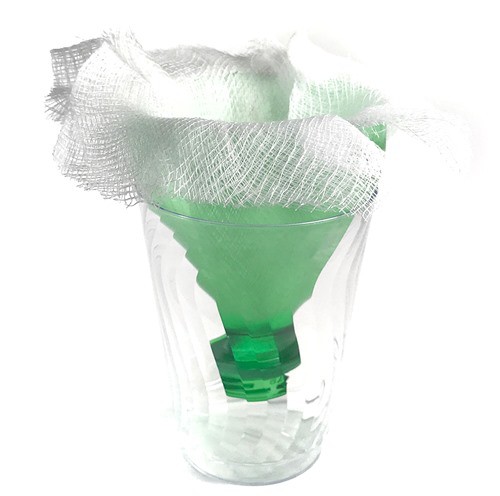 Image Credit: Svenja Lohner, Science Buddies / Science Buddies
Image Credit: Svenja Lohner, Science Buddies / Science Buddies
- Remove the green tops from the strawberries and discard the tops. Put the strawberries in a re-sealable plastic sandwich bag and push out all of the extra air. Seal the bag tightly.
- With your fingers, squeeze and smash the strawberries for two minutes. How do the smashed strawberries look?
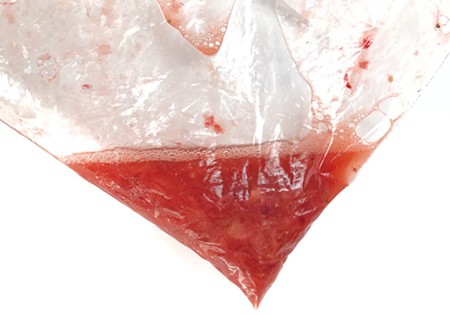 Image Credit: Svenja Lohner, Science Buddies / Science Buddies
Image Credit: Svenja Lohner, Science Buddies / Science Buddies
- Add 3 tbsp. of the extraction liquid you prepared to the strawberries in the bag. Push out all of the extra air and reseal the bag.How do you think the detergent and salt will affect the strawberry cells?
- Squeeze the strawberry mixture with your fingers for one minute. How do the smashed strawberries look now?
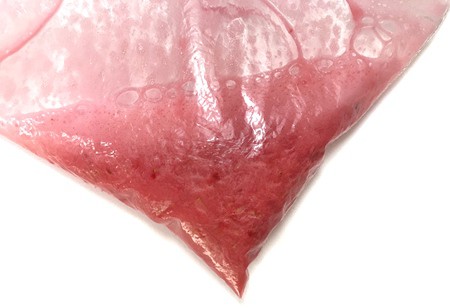 Image Credit: Svenja Lohner, Science Buddies / Science Buddies
Image Credit: Svenja Lohner, Science Buddies / Science Buddies
- Pour the strawberry mixture from the bag into the funnel. Let it drip through the cheesecloth and into the tall glass until there is very little liquid left in the funnel (only wet pulp remains). How does the filtered strawberry liquid look?
- Pour the filtered strawberry liquid from the tall glass into the small glass jar so that the jar is ¼ full.
- Measure out ½ C of cold rubbing alcohol. Tilt the jar and very slowly pour the cold rubbing alcohol down the side of the jar. Pour until the alcohol has formed approximately a one-inch deep layer on top of the strawberry liquid. You may not need all of the ½ cup of alcohol to form the one-inch layer. Do not let the strawberry liquid and alcohol mix.
- Study the mixture inside of the jar. The strawberry DNA will appear as gooey clear/white stringy stuff.Do you see anything in the jar that might be strawberry DNA? If so, where in the jar is it?
 Image Credit: Svenja Lohner, Science Buddies / Science Buddies
Image Credit: Svenja Lohner, Science Buddies / Science Buddies
- Dip the bamboo skewer into the jar where the strawberry liquid and alcohol layers meet and then pull up the skewer.Did you see anything stick to the skewer that might be DNA? Can you spool any DNA onto the skewer?
What Happened?
When you added the mixture of salt and detergent (i.e., the dishwashing liquid) to the smashed strawberries, the detergent helped lyse (or pop open) the strawberry cells. This caused the cells to release their DNA into the liquid in the bag. At the same time, the salt helped create an environment where the different strands of DNA could gather together in a clump, making it easier for you to see them. (When you added the salt and detergent mixture, you probably mostly just saw more bubbles form in the bag, due to the detergent.) When you added the cold rubbing alcohol to the filtered strawberry liquid, the alcohol should have made the DNA come together and separate itself from the rest of the liquid. You should have seen the white/clear gooey DNA strands in the alcohol layer, as well as between the two layers. A single strand of DNA is extremely tiny, too tiny to see with the naked eye, but because the DNA clumped together in this activity you were able to see just how much DNA three strawberries have when combining all of their octoploid cells! ("Octoploid" means they have eight genomes, or sets of their genes.)
Digging Deeper
Whether you are a human, rat, tomato, or bacterium, each cell will have DNA inside of it (with some rare exceptions, such as mature red blood cells in humans). Each cell has an entire copy of the same set of instructions, and this set is called the genome. Scientists study DNA for many reasons. They can figure out how the instructions stored in DNA help your body to function properly. They can use DNA to make new medicines. They can genetically modify foods to be resistant to insects. They can figure out the suspect of a crime. They can even use ancient DNA to reconstruct evolutionary histories!
To get the DNA from a cell, scientists do a DNA extraction. There are many DNA extraction kits available from biotechnology companies for scientists to use. During a DNA extraction, a detergent will cause the cell to pop open, or lyse, so that the DNA is released into surrounding liquid. Then the DNA is separated from the rest of the liquid (a process called precipitation) by adding alcohol. In this activity, strawberries are used because each strawberry cell has eight copies of the genome, giving them a lot of DNA per cell. (Most organisms only have one genome copy per cell.)
Ask an Expert
For Further Exploration
- You can try this DNA extraction activity to purify DNA from lots of other things. Grab some oatmeal or kiwis from the kitchen and try it again! Which foods give you the most DNA?
- If you have access to a milligram scale (called a balance), you can measure how much DNA you get (called a yield). Just weigh your clean bamboo skewer and then weigh the skewer again after you have used it to fish out as much DNA as you could from your strawberry DNA extraction. Subtract the initial weight of the skewer from its weight with the DNA to get your final yield of DNA. What was the weight of your DNA yield?
- Try to tweak different variables in this activity to see how you could change your strawberry DNA yield. For example, you could try starting with different amounts of strawberries, using different detergents, or using different starting sources of DNA (such as oatmeal or kiwis). Which conditions give you the best DNA yield?


